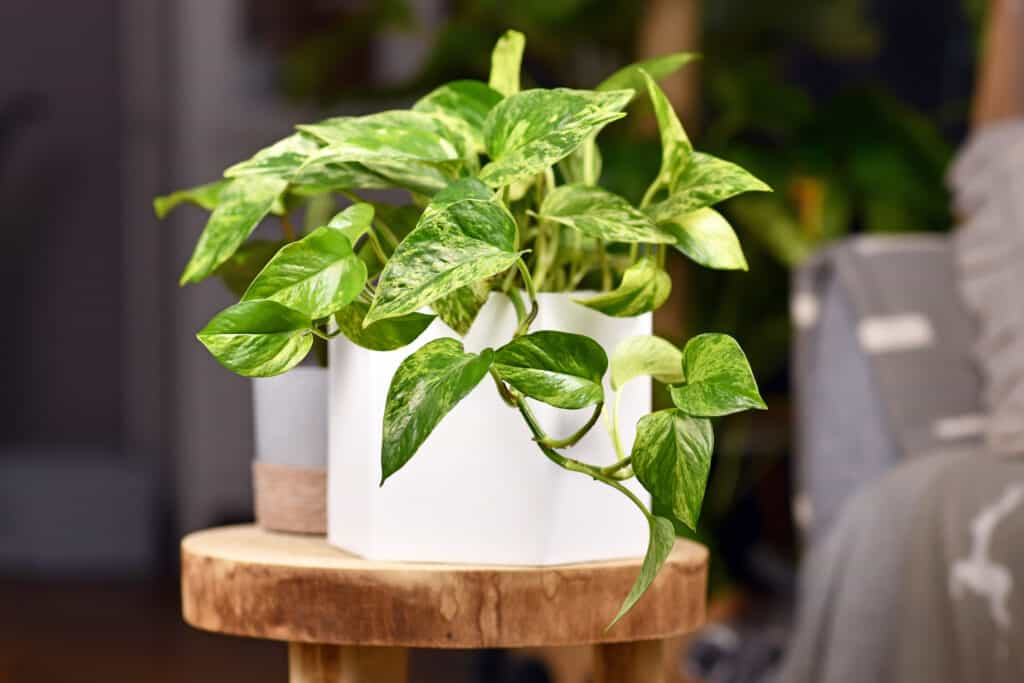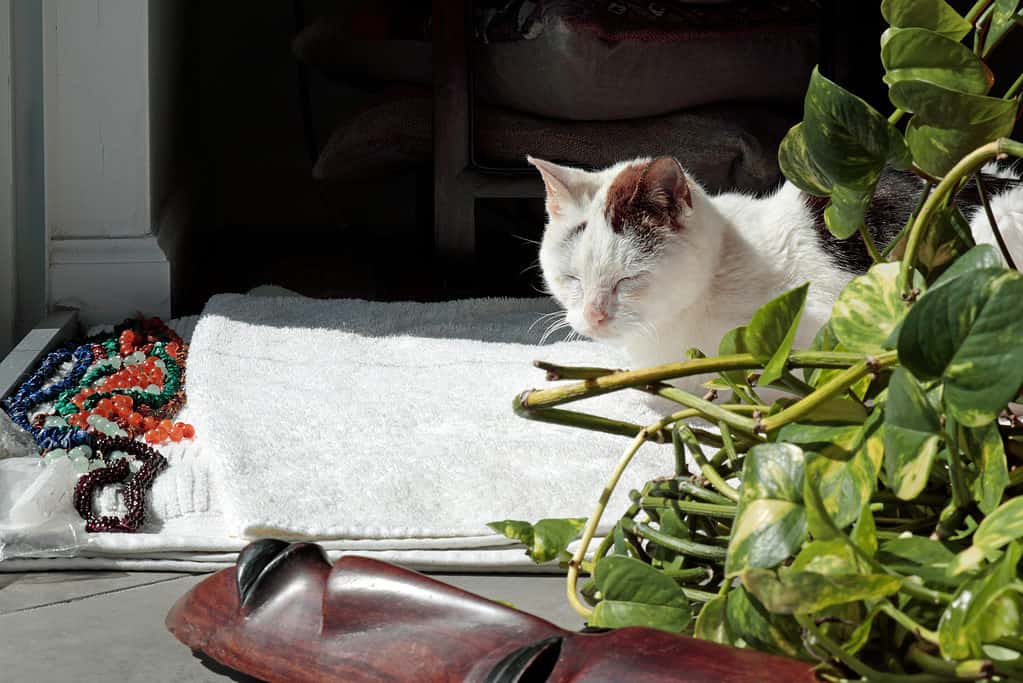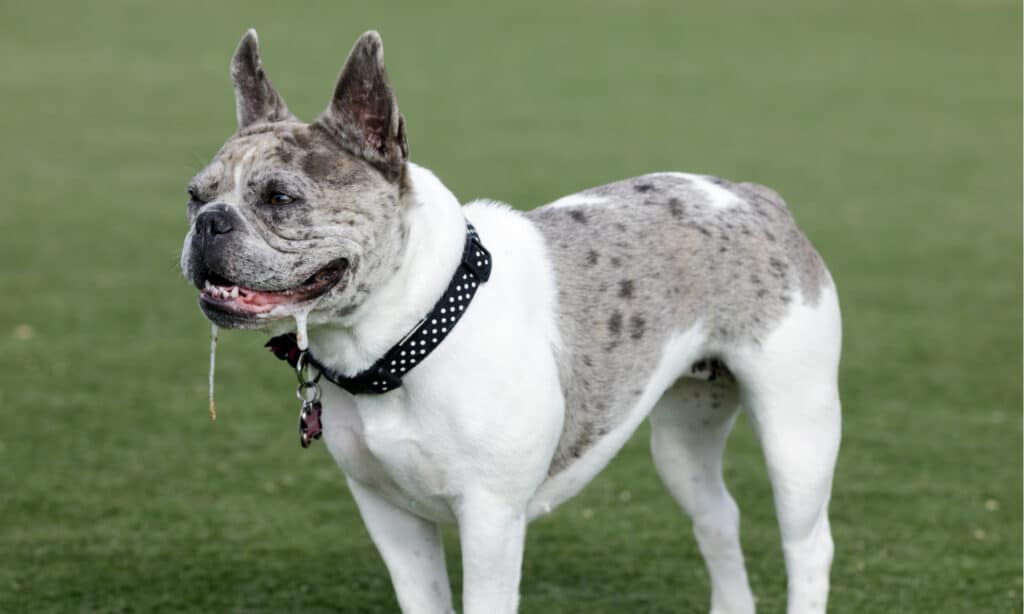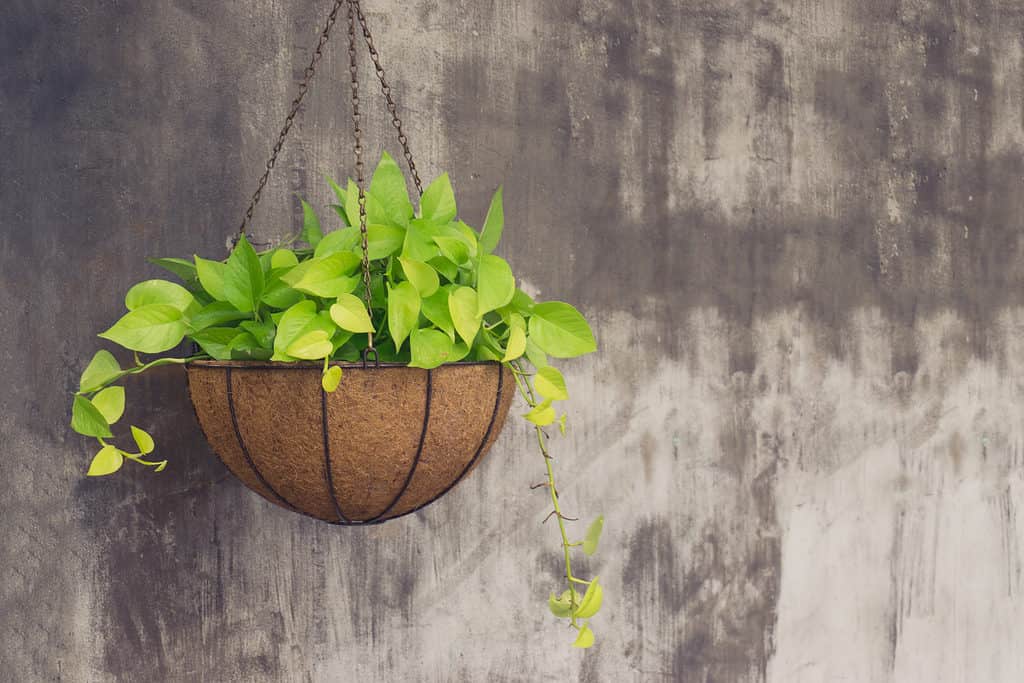Pothos plants are a popular favorite for houseplant enthusiasts due to their resilient nature and lovely trailing vines. However, if you share your home with dogs or cats, you may wonder if pothos plants are toxic to your furry companions. The short answer is yes, although the pothos toxicity level is generally not severe.
In this guide, we’ll discuss what parts of the plants are toxic to dogs and cats, what toxin causes the poisoning, how to minimize the risk of a pet ingesting this plant, and what to do if a pothos plant poisons your furry friend.
So, without further ado, let’s jump in!
An Intro to Pothos
Before we talk about pothos toxicity, we’ll briefly discuss what a pothos plant is and where it originated. Epipremnum aureum, commonly called pothos and devil’s ivy, is a lovely climbing vine native to the Solomon Islands of the South Pacific. In the wild, this plant can grow to massive lengths of up to 65 feet long with stunning, variegated leaves that are 3 feet long.
As a houseplant, pothos and its various cultivars remain in their juvenile phase, in which they grow up to 10 feet long and typically live about 10 years. These plants are well-loved for their highly resilient nature (hence the common name of devil’s ivy) and are easily one of the most popular indoor plants in the US for homes, stores, and offices.
However, while they’re quite easy to grow and are available in a variety of lovely, interesting cultivars, these plants are indeed toxic to dogs and cats. In fact, they’re also toxic to people when ingested. So, we’ll discuss more below about this toxicity and how to help keep your beloved furry family members safe.

Pothos (devil’s ivy) is easy to grow and available in a wide variety of cultivars, but they are also toxic to dogs and cats.
©iStock.com/Firn
What Toxin Does Pothos Contain?
Like many other plants in the Araceae family, such as peace lily, Epipremnum aureum contains insoluble calcium oxalate crystals. All parts of the plant contain these microscopic needle-like crystals, which cause irritation upon ingestion. However, the leaves contain the highest concentration. As you might guess, these irritating crystals help protect pothos from herbivores looking to snack on them. Its sap also contains calcium oxalate, so if you break apart the stem, skin irritation may occur as well.
Pothos Toxicity: What Are the Symptoms and Severity of Ingestion?
Thankfully, most cases of pothos ingestion cause mild to moderate symptoms, with the Missouri poison center advising that most cases can be handled at home under the guidance of a poison control center.
However, if your pup or cat does chew on this plant, it’s important to know what signs and symptoms to expect. It’s also important to understand the mechanism of toxicity. As your pet chews on the plant, the microscopic needles cause damage to the mouth, throat, and digestive tract, which results primarily in pain and swelling. This intense irritation can cause salivating, vomiting, and diarrhea in your pet as the body tries to eliminate the toxin. Often, the cat or dog won’t actually swallow pothos leaves or stems as the immediate pain and swelling in the mouth will typically cause them to spit the plant out.

If your pet chews on pothos leaves, the microscopic needles can cause damage to their mouth, throat, and digestive tract.
©Serenethos/Shutterstock.com
Note the Medical Signs
So, the signs you’ll typically see with pothos poisoning of cats and dogs are:
- Excessive drooling
- Irritation/swelling of the eyes, mouth, tongue, and nose
- Vomiting
- Diarrhea
- If ingested, irritation and swelling of the gastrointestinal tract
- In rare cases, difficulty breathing or respiratory distress
- In rare cases, when large amounts of pothos are consumed, the build-up of calcium oxalate crystals in the urine (calcium oxalate crystalluria)
Note the Behavioral Signs
In addition to seeing medical signs of pothos poisoning, you will likely also witness behavioral signs that your pet is distressed. These signs may include:
- Pawing at the face/throat
- Yelping/crying/whining
- Panting
- Stress yawning
- Fast, darting, panicked movements
- Defensiveness/guarding against touch
Now, usually, the effects of the calcium oxalate crystals aren’t too severe. However, if the body’s system has a strong enough reaction, the throat can swell to the point that breathing becomes difficult. At this point, emergency veterinary intervention is often necessary. Additionally, if large quantities are consumed, your pet may experience a buildup of calcium oxalate crystals that will require medical treatment.

Some signs you’ll typically see with pothos poisoning of cats and dogs are panting and excessive drooling.
©yhelfman/Shutterstock.com
Pothos Toxicity: What to do If Your Pet Chews or Ingests Pothos
So, if your kitty or pup starts showing signs of irritation from calcium oxalate, the first step is to actually confirm the pothos plant is the cause of the irritation. If you or a trustworthy witness didn’t actually see your pet chew the plant, check the pothos for signs of leaf or stem damage. This is important as a different medical problem could be occurring that may be more serious, and you wouldn’t want to assume that your pet chewed on pothos without confirming this.
Once you’re sure that the pothos plant is the cause of your dog or cat’s signs and symptoms, you’ll want to contact your vet for guidance, help alleviate the pain, and monitor your pet for signs of throat swelling and breathing difficulty. Depending on the signs your pet is displaying, and whether your pet just chewed or actually ingested the plant, your vet may advise specific at-home care or advise you to bring your pet in. If your pet is having difficulty breathing, take them to your vet or an emergency vet immediately.
At Home Care
Depending on the instructions from your vet, at-home care for your pet following pothos poisoning may include the following:
- Rinsing the mouth thoroughly to help flush out the crystals
- Administering appropriate oral antihistamines
- Giving soft dairy like cottage cheese, which can help soothe the pain
- Preventing dehydration from diarrhea and vomiting by encouraging lots of water intake
- Administering appropriate anti-pain meds
Veterinary Intervention
If your pet consumed a large quantity of the plant or displays serious symptoms such as severe swelling or difficulty breathing, immediately take them to the vet. Once there, your vet will examine your pet and provide care based on symptoms or results from blood work. Veterinary intervention may include:
- IV therapy
- Oxygen support or intubation
- Treatment for calcium oxalate buildup
- Pain and swelling alleviation
- Vomiting inducing to eliminate the ingested plant material
Pothos Toxicity: How to Prevent Poisoning of Your Pet
If you’re concerned about pothos toxicity and your pet becoming poisoned, the best move is to prevent your cat or dog from being able to reach the plant. It’s impossible to keep an ever-watchful eye on the pets in your home, so displaying your pothos plant(s) in a safe, out-of-reach manner is the best way to ensure you can enjoy your houseplants while keeping your furry friends safe. With some planning and creativity, you can have the best world of plants and pets in your home.
There are a number of ways to display a pothos vine while minimizing the risk to your cats or dogs. Solutions include keeping your plant up on an un-climbable shelf, in a hanging basket, or in a room that your pets are separated from. For instance, you could display your pothos on a bathroom window ledge (where it will enjoy higher humidity) but keep the door closed. As a trailing vine, pothos looks lovely in a hanging basket or up high on a shelf. Of course, as this plant can reach up to 10 feet long indoors, you may need to clip the plant back or train the vines linearly along high-up shelving to keep a pet from reaching part of the vine.

Planting your pothos in a hanging basket is a good way to minimize the risk to your cat or dog.
©Phodsapon Longvilai/Shutterstock.com
The photo featured at the top of this post is © B.Theerawoot/Shutterstock.com
Sources
- Jadhav DR, Gugloth R. Poisoning due to Arisaema triphyllum Ingestion. Indian J Crit Care Med. 2019 May;23(5):242-243. doi: 10.5005/jp-journals-10071-23171. PMID: 31160845; PMCID: PMC6535988., Available here: https://www.ncbi.nlm.nih.gov/pmc/articles/PMC6535988/
- Missouri Poison Center, Available here: https://missouripoisoncenter.org/is-this-a-poison/devils-ivy/
- ASPCA, Available here: https://www.aspca.org/pet-care/animal-poison-control/toxic-and-non-toxic-plants/golden-pothos
- Vetlexicon, Available here: https://www.vetlexicon.com/treat/canis/diseases/plant-poisoning-calcium-oxalate
Thank you for reading! Have some feedback for us? Contact the AZ Animals editorial team.






